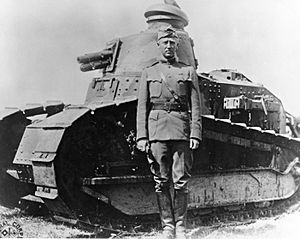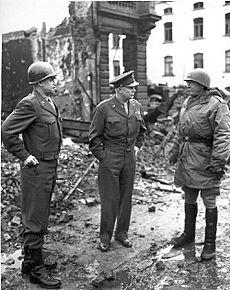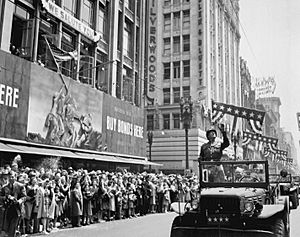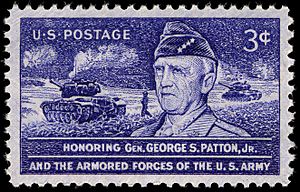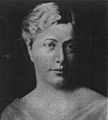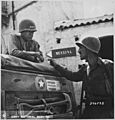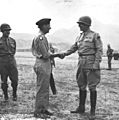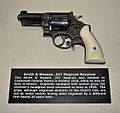George S. Patton facts for kids
Quick facts for kids
George S. Patton
|
|
|---|---|
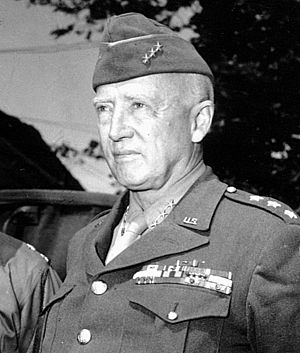
George S. Patton as a lieutenant general
|
|
| Nickname(s) | Bandito, Old Blood and Guts, The Old Man |
| Born | November 11, 1885 San Gabriel, California |
| Died | December 21, 1945 (aged 60) Heidelberg, Occupied Germany |
| Place of burial |
American Cemetery and Memorial
(49°36′42″N 06°11′08″E / 49.61167°N 6.18556°E)Luxembourg City, Luxembourg |
| Allegiance | |
| Service/ |
|
| Years of service | 1909–1945 |
| Rank | |
| Spouse(s) |
Beatrice Banning Ayer
(m. 1910) |
| Children | Beatrice Smith Ruth Ellen George Patton IV |
| Relations | Major General George Patton IV (son) General John K. Waters (Son in law) |
| Signature | |
George Smith Patton, Jr. (November 11, 1885 – December 21, 1945) was an important officer in the U.S. Army. He served in the army from 1909 until his death in 1945. He was a key leader who helped defeat Germany during World War II in Europe.
Patton was born in San Gabriel, California. He married Beatrice Banning Ayer in 1910, and they had three children.
Patton died on December 21, 1945, at age 60, after a car accident in Heidelberg, Germany. He was buried at the American Cemetery and Memorial in Luxembourg City, Luxembourg.
Contents
Early Life and Education
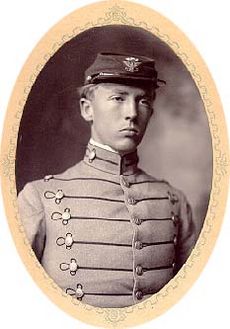
George Smith Patton Jr. was born on November 11, 1885, in San Gabriel, California. His parents were George Smith Patton Sr. and Ruth Wilson. He had a younger sister named Anne, who was called "Nita."
As a child, Patton had trouble learning to read and write. This might have been because he had dyslexia. However, he worked hard and became a great reader as an adult. He was also known as a smart boy and a very good horseback rider.
On May 26, 1910, Patton married Beatrice Banning Ayer in Beverly Farms, Massachusetts. They had three children: Beatrice Smith, Ruth Ellen, and George Patton IV.
Patton attended the Virginia Military Institute from 1903 to 1904. Even though he struggled with schoolwork, he was excellent at military drills and keeping his uniform neat. A senator from California helped him get into West Point.

At West Point, he continued to be great at military training, but his grades were average. He was a cadet sergeant major and later a cadet adjutant. He joined the sword team and the track and field team. He was especially good at the modern pentathlon, a sport with five different events. He competed in this sport at the 1912 Summer Olympics in Stockholm, finishing fifth.
Patton graduated from West Point on June 11, 1908. He became a second lieutenant in the Cavalry branch of the United States Army.
Military Career
Patton first experienced combat in 1916 during the Pancho Villa Expedition. This was the first time the American military used motor vehicles in action.
He fought in World War I as part of the new U.S. Tank Corps. He led the U.S. tank school in France and then commanded tanks in battle. He was wounded near the end of the war.
Between World War I and World War II, Patton helped create new ideas for how the army should use armored warfare (tanks and other armored vehicles). When the U.S. entered World War II, he was in charge of the 2nd Armored Division.
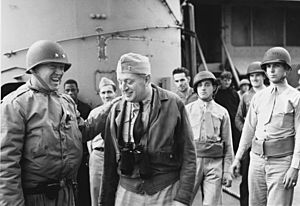
Patton led U.S. troops into the Mediterranean Sea during Operation Torch in 1942, invading Casablanca. He quickly became known as a very effective commander.
He then commanded the U.S. Seventh Army during the Allied invasion of Sicily. He was the first Allied commander to reach Messina on the island.
Later, he played a key role in Operation Fortitude. This was a plan by the Allies to trick the enemy about where the main invasion of Europe would happen.
When the Western Allies invaded France, Patton was given command of the Third Army. His army moved very quickly across France using armored vehicles. Under his strong leadership, the Third Army helped rescue American troops at Bastogne during the Battle of the Bulge. After this, his forces pushed deep into Nazi Germany by the end of the war.
After the war, during the Allied occupation of Germany, Patton was made military governor of Bavaria. However, he was removed from this job because he made some comments that caused problems, especially about the Soviet Union. He then commanded the United States Fifteenth Army for a short time.
Major Battles
- Battle of San Miguelito
- World War I:
- Saint Mihiel Campaign
- Meuse-Argonne Campaign
- World War II:
Awards and Honors
Patton received many awards for his bravery and leadership, including:
- Distinguished Service Cross
- Distinguished Service Medal
- Silver Star
- Legion of Merit
- Bronze Star
- Purple Heart
- Companion of the Order of the Bath (British)
- Knight Commander of the Order of the British Empire (British)
- Legion of Honor (French)
- Order of the White Lion (Czech)
Accident and Death
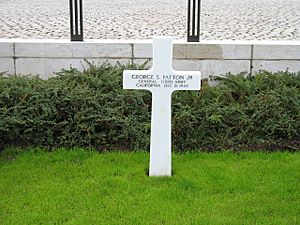
On December 8, 1945, Patton was going on a hunting trip near Speyer, Germany. His car crashed into an American army truck at a slow speed.
Others in the car were only slightly hurt, but Patton hit his head on a glass partition in the back seat. He started bleeding and said he couldn't move and had trouble breathing. He was taken to a hospital in Heidelberg. Doctors found that he had a broken neck and a serious spinal cord injury, which made him paralyzed from the neck down.
Patton spent the next 12 days in the hospital, trying to recover. He died in his sleep on December 21, 1945, from complications related to his injuries.
He was buried at the Luxembourg American Cemetery and Memorial in Luxembourg City. He had asked to "be buried with [his] men," so he rests alongside soldiers from his Third Army who died during the war.
Legacy
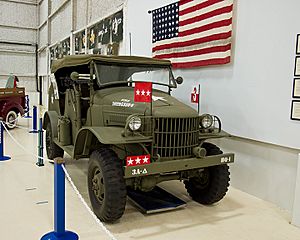
George S. Patton was known for his colorful personality and strong leadership. He was a very successful commander. He believed in leading from the front and giving inspiring speeches to his troops. His soldiers liked him, but sometimes his strong opinions caused problems with other Allied leaders.
His focus on fast and aggressive attacks was very effective in battle. Even his opponents in the German High Command respected his skills as a military leader.
Patton has been shown in many movies and TV shows. One of the most famous portrayals was by George C. Scott in the 1970 film Patton. This movie helped make Patton a well-known figure in popular culture.
Images for kids
-
Patton as a temporary colonel at Camp Meade, Maryland, 1919.
-
Comedian Bob Hope (second from left) and others meet George Patton in Sicily during World War II.
-
From left to right, Brigadier General Theodore Roosevelt Jr., Major General Terry Allen and Lieutenant General George S. Patton, March 1943.
-
Lieutenant Colonel Lyle W. Bernard and Lieutenant General George S. Patton near Brolo, Sicily, July 1943.
-
General Sir Bernard Montgomery shakes hands with Lieutenant General George S. Patton at an airport at Palermo, Sicily, July 28, 1943.
-
Patton pins a Silver Star Medal on Private Ernest A. Jenkins, October 1944.
-
From left to right: Major General Leven C. Allen, Lieutenant General Omar Bradley, Major General John S. Wood, Lieutenant General George S. Patton and Major General Manton S. Eddy near Metz, France, November 1944.
-
A statue of Patton at the US Military Academy at West Point.
-
Patton's boots at a museum in Malmedy.
See also
 In Spanish: George Patton para niños
In Spanish: George Patton para niños


